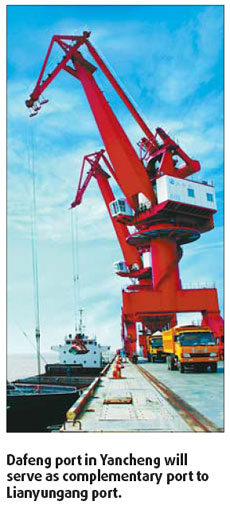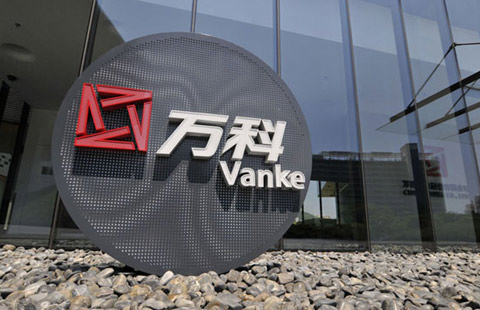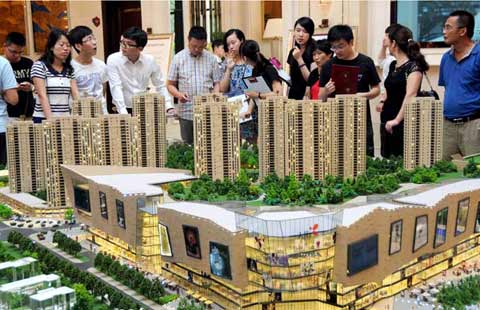

"We are making full use of our geographical advantages. This will boost our port construction program, which will, in turn, act as a massive spur for the overall development of Dafeng city itself," says Ni Xiangrong, director of the administrative committee of the Dafeng port economic zone.
Ni's almost evangelical zeal for the project that is about to transform the prospects of his home city is, perhaps, understandable when you begin to understand the scheme's wider ramifications.
Dafeng, a county-level city in Yancheng, part of the eastern Jiangsu province, enjoys an enviable location, sure to be the envy of the many freight facilities competing for business along China's east coast.
Located almost at the very mid-point of Jiangsu's 954-km-long coastline, it is undergoing a period of rapid development as it gears up to become one of the key marine transportation hubs between Shanghai, in the south, and Lianyungang, at the very northern tip of Jiangsu.

The zone covers an area of 500 sq km with a planned construction area of 200 sq km, of which 60 sq km has been under construction.
In order to ensure its accelerated development, a number of key goals were identified at the inception of the project while a far-reaching and meticulous blueprint was drafted to ensure the faultless execution of the project.
Recalling the planning phase, Ni said: "We undertook meticulous studies prior to the construction of the port economic zone. We have learnt extensively from the experiences of other regions and tailored their solutions to match our local conditions and requirements.
"We now aim to develop the local economy in tandem with the construction of the port. We see the expanded facilities as a propeller to drive the development of the ancillary port industries and the overall prosperity of Dafeng itself."
Construction work on the project began in 1998 and the first phase of the port went into operation in 2005, following the completion of two 10,000-ton wharfs. Since then, the construction tempo has sped up and two additional 50,000-ton wharfs are now scheduled for completion later this year.
Even prior to its extended capacity coming on-line, the port has already established a large number of domestic freight routes, while its international routes now reach as far afield as Pusan and Inchon in South Korea and the Japanese port of Nagasaki.
Looking to the future, Ni says confidently: "Our transportation capacity will reach 20 million tons next year and 30-50 million tons by 2012, together with 10 individual freight-handling berths."
While maintaining a clear focus on the construction of the port, Ni and his team have also made considerable efforts to attract investment and develop the facility's ancillary industries.
These efforts have now started to pay off. The zone now features five industrial areas - a portside logistics park, a north portside industrial area, a south portside industrial area, a suburban leisure and resort area and a pharmaceutical science and technological park.
Ni said: "We are focusing on investment in new energy sources, new materials and the processing of agricultural and marine products. We are also looking at cultivating interests in the pharmaceutical industry."
As a result of China's manifestly long coastline, a large number of coastal cities have traditionally competed for resources, customers and financial support from the government in order to boost their own development.
According to Ni, though, this has changed somewhat, with the current round of inter-port competition proving to be market-driven rather than a government-primed phenomenon. This, he says, shows that there is now an expectation of considerable financial returns from the commercial sector.
Outlining the future for the industry, Ni said: "While we also have considerable investment from the private sector, we believe that competition will ultimately drive out the smaller players. In order to survive in this increasingly competitive market, we plan to optimize our own port resources, while working to further enhance the industrial structure of our port development zone."
 Beijing destroys 1,501 illegal motorcycles
Beijing destroys 1,501 illegal motorcycles
 Top 10 Chinese realty developers in 2014
Top 10 Chinese realty developers in 2014
 Business opportunities of 'Year of the Sheep'
Business opportunities of 'Year of the Sheep'
 High-speed train named after Henan firm
High-speed train named after Henan firm
 UAV used to inspect electricity line
UAV used to inspect electricity line
 We run errands so you don't have to
We run errands so you don't have to
 Top 11 economic data of China in 2014
Top 11 economic data of China in 2014
 Post-doctor quits math study and sells beef noodles online
Post-doctor quits math study and sells beef noodles online